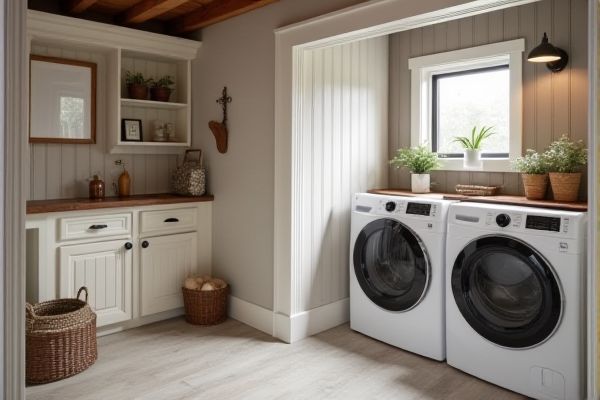
A laundry area in the basement offers a dedicated space for washing and drying clothes, optimizing functionality and organization, while a mudroom provides a practical entryway for storing shoes, coats, and outdoor gear, helping keep your home clean and clutter-free. Explore the rest of the article to discover which option best suits your home's layout and your lifestyle needs.
Table of Comparison
| Feature | Laundry Area | Mudroom Basement |
|---|---|---|
| Primary Function | Washing and drying clothes | Entryway for removing shoes, coats, and storing outdoor gear |
| Location | Often near bathrooms or kitchens, sometimes in basements | Typically located near outdoor entrances, often in basement level |
| Design Elements | Washing machines, dryers, countertops, sinks, storage cabinets | Benches, hooks, storage cubbies, durable flooring, ventilation |
| Primary Benefits | Convenient clothing care, centralized laundry tasks | Keeps dirt and mud contained, organized outdoor gear storage |
| Water Access | Required (plumbing for washer and sink) | Usually limited or none |
| Flooring Type | Water-resistant, easy to clean (tile, vinyl) | Durable, dirt-resistant materials (rubber, tile, concrete) |
| Storage | Laundry detergents, baskets, cleaning supplies | Outdoor clothing, shoes, sports equipment |
| Common Challenges | Noise, moisture control | Managing mud/dirt, adequate ventilation |
Introduction: Laundry Area vs Mudroom Basement
A laundry area in the basement is primarily designed for washing, drying, and folding clothes, featuring appliances like washers, dryers, and storage for detergents. A mudroom basement serves as a transitional space equipped with seating, storage for shoes and coats, and durable flooring to manage dirt and moisture brought from outdoors. Choosing between the two depends on whether the focus is on managing laundry tasks efficiently or organizing entryway clutter and outdoor gear.
Defining Laundry Area and Mudroom Basement
A laundry area is a designated space equipped with washers, dryers, and storage for cleaning supplies, designed primarily for washing and drying clothes efficiently. A mudroom basement serves as a transitional zone between outdoors and indoors, typically featuring storage for shoes, coats, and outdoor gear to keep dirt from spreading throughout the home. Your choice between the two depends on whether functionality for laundry tasks or managing outdoor mess is your priority.
Key Functions and Purposes
The laundry area in a basement primarily focuses on washing, drying, and folding clothes with appliances such as washers and dryers designed for efficient garment care. The mudroom basement serves as a transitional space for removing muddy shoes, wet coats, and storing outdoor gear, preventing dirt from entering the main living areas. Both spaces optimize functionality by organizing household chores and maintaining cleanliness but cater to different daily activities and storage needs.
Space and Layout Considerations
Laundry areas in basements typically require efficient use of space to accommodate washers, dryers, and utility sinks, emphasizing ventilation and easy access to plumbing. Mudroom basements prioritize organized storage for shoes, coats, and outdoor gear, often featuring built-in benches and cubbies to maximize functionality. Your choice between the two should consider how much room you have and whether you need more washing capacity or storage and transition space.
Storage Solutions and Organization
A mudroom basement offers versatile storage solutions with built-in cubbies, benches, and hooks, perfect for organizing shoes, coats, and outdoor gear, while a dedicated laundry area prioritizes space for detergents, hampers, and cleaning supplies in cabinets and shelves. Efficient organization in a mudroom basement keeps clutter contained near entry points, enhancing home cleanliness, whereas your laundry area benefits from stackable washers and dryers paired with fold-out countertops for seamless workflow. Both spaces can incorporate modular storage systems tailored to specific needs, maximizing utility and maintaining tidiness.
Design and Aesthetic Appeal
A laundry area in the basement often features practical design elements such as durable flooring and ample storage cabinets, optimizing functionality while maintaining a clean, organized look. Mudrooms typically incorporate rustic or natural materials like wood benches, hooks, and durable mats, enhancing aesthetic appeal through warmth and texture. Combining both spaces can create a cohesive design that balances utility and style, making the basement more inviting and visually appealing.
Practicality for Busy Households
A basement laundry area offers ample space for sorting, washing, and folding clothes, making it highly practical for busy households handling large loads frequently. Mudrooms with laundry zones combine entryway storage with laundry functions, streamlining clean-up and organization after outdoor activities. Both setups enhance efficiency, but dedicated basement laundry rooms typically provide superior capacity and noise reduction.
Maintenance and Cleaning Tips
Laundry areas and mudroom basements require regular maintenance to prevent dirt and moisture buildup that can cause mold and damage. You should frequently clean lint traps, mop floors, and disinfect surfaces to maintain hygiene and functionality. Proper ventilation and organizing storage solutions also help reduce clutter and keep both spaces clean and efficient.
Cost Comparison and Budget Planning
A mudroom basement typically incurs higher renovation costs than a laundry area due to added features like storage cabinets, seating, and durable flooring designed for heavy wear. Budget planning for a mudroom basement must account for waterproofing, enhanced lighting, and custom cabinetry, often increasing expenses by 20-30% compared to a standard laundry area. Opting for a simple laundry area focuses costs primarily on appliances and plumbing, maintaining a lower overall budget with fewer structural modifications.
Choosing the Right Option for Your Home
Selecting between a laundry area and a mudroom basement depends on your home's layout, usage habits, and storage needs. A dedicated laundry area with waterproof flooring and built-in cabinetry maximizes efficiency for washing and folding clothes, while a mudroom basement offers ample space for storing outdoor gear, shoes, and cleaning up before entering the main living areas. Prioritize moisture control, ventilation, and accessibility when deciding which space best complements your household's daily routines and prevents dirt from spreading throughout the home.
 homyna.com
homyna.com